Complex Mandibular Reconstruction for Head and Neck Squamous Cell Carcinoma—The Ongoing Challenge in Reconstruction and Rehabilitation
Simple Summary
Abstract
1. Introduction
2. Results
3. Discussion
3.1. The Pedicle
3.2. The Bony Graft
3.3. The Skin Graft
3.4. Dental Rehabilitation
3.5. Quality of Life
4. Materials and Methods
4.1. Patients
4.2. Quality of Life Assessment
4.2.1. The EORTC QLQ-C30
4.2.2. The EORTC QLQ-H&N43
4.3. Data Collection
4.4. Statistical Analysis
Statistical Evaluation of the EORTC Questionnaires
- High values in the function scales: high/better function level and low level of restriction
- High scores on the Global Health and QoL scale: high quality of life
- High values in the symptom scales: high/worse symptom level and high level of complaints
5. Conclusions
Author Contributions
Funding
Acknowledgments
Conflicts of Interest
References
- Daniel, R.K.; Taylor, G.I. Distant transfer of an island flap by microvascular anastomoses: A clinical technique. Plast. Reconstr. Surg. 1973, 52, 111–117. [Google Scholar] [CrossRef] [PubMed]
- O’Brien, B.M.; Macleod, A.M.; Hayhurst, J.W.; Morrison, W.A. Successful transfer of a large island flap from the groin to the foot by micro-vascular anastomoses. Plast. Reconstr. Surg. 1973, 52, 271–278. [Google Scholar] [CrossRef]
- Baudet, J.; Guimberteau, J.-C.; Nascimento, E. Successful clinical transfer of two free thoraco-dorsal axillary flaps. Plast. Reconstr. Surg. 1976, 58, 680–688. [Google Scholar] [CrossRef]
- Swartz, W.M.; Banis, J.C.; Newton, E.D.; Ramasastry, S.S.; Jones, N.F.; Acland, R. The osteocutaneous scapular flap for mandibular and maxillary reconstruction. Plast. Reconstr. Surg. 1986, 77, 530–545. [Google Scholar] [CrossRef] [PubMed]
- Urken, M.L.; Bridger, A.G.; Zur, K.B.; Genden, E.M. The Scapular Osteofasciocutaneous Flap: A 12-Year Experience. Arch. Otolaryngol. Head Neck Surg. 2001, 127, 862–869. [Google Scholar] [PubMed]
- Jones, N.F.; Swartz, W.M.; Mears, D.C.; Jupiter, J.B.; Grossman, A. The “double barrel” free vascularized fibular bone graft. Plast. Reconstr. Surg. 1988, 81, 378–385. [Google Scholar] [CrossRef]
- Granick, M.S.; Ramasastry, S.S.; Newton, E.D.; Solomon, M.P.; Hanna, D.C.; Kaltman, S. Reconstruction of complex maxillectomy defects with the scapular–free flap. Head Neck 1990, 12, 377–385. [Google Scholar] [CrossRef] [PubMed]
- Van Thienen, C.E.; Deraemaecker, R. The serratus anterior scapular flap—A new osteomuscular unit. Eur. J. Plast. Surg. 1988, 11, 156–161. [Google Scholar] [CrossRef]
- Coleman, J.J.; Sultan, M.R. The bipedicled osteocutaneous scapula flap: A new subscapular system free flap. Plast. Reconstr. Surg. 1991, 87, 682–692. [Google Scholar] [CrossRef]
- Kärcher, H. Transplantation of the scapular bone vascularized by the thoracodorsal vessels. A new method of scapula transplantation. Dtsch. Z. Mund Kiefer Gesichts Chir. 1991, 15, 186–192. [Google Scholar]
- Seitz, A.; Papp, S.; Papp, C.; Maurer, H. The anatomy of the angular branch of the thoracodorsal artery. Cells Tissues Organs. 1999, 164, 227–236. [Google Scholar] [CrossRef] [PubMed]
- Clark, J.R.; Vesely, M.; Gilbert, R. Scapular angle osteomyogenous flap in postmaxillectomy reconstruction: Defect, reconstruction, shoulder function, and harvest technique. Head Neck 2008, 30, 10–20. [Google Scholar] [CrossRef]
- Brown, J.; Bekiroglu, F.; Shaw, R. Indications for the scapular flap in reconstructions of the head and neck. Br. J. Oral Maxillofac. Surg. 2010, 48, 331–337. [Google Scholar] [CrossRef] [PubMed]
- The World Health Organization. Quality of Life Assessment (WHOQOL): Position Paper from the World Health Organization. Soc. Sci. Med. 1995, 41, 1403–1409. [Google Scholar] [CrossRef]
- Dietz, A.; Meyer, A.; Singer, S. Measuring quality of life in head and neck cancer: Current status and future needs. HNO 2009, 57, 857–865. [Google Scholar] [CrossRef]
- Egger, J.W. Das biopsychosoziale Krankheitsmodell- Grundzüge eines wissenschaftlich begründeten ganzheitlichen Verständnisses von Krankheit. Psychol. Med. 2005, 16, 3–12. [Google Scholar] [CrossRef]
- Karimi, M.; Brazier, J. Health, Health-Related Quality of Life, and Quality of Life: What is the Difference? Pharmacoeconomics 2016, 34, 645–649. [Google Scholar] [CrossRef]
- Daig, I.; Lehmann, A. Verfahren zur Messung der Lebensqualität. Zeitschrift fur Medizinische Psychologie 2007, 16, 5–23. [Google Scholar]
- Rogers, S.N.; Lowe, D.; Brown, J.S.; Vaughan, E.D. A comparison between the University of Washington Head and Neck Disease-Specific Measure and the Medical Short Form 36, EORTC QOQ-C33 and EORTC Head and Neck 35. Oral Oncol. 1998, 34, 361–372. [Google Scholar] [CrossRef]
- Urken, M.L.; Weinberg, H.; Vickery, C.; Buchbinder, D.; Lawson, W.; Biller, H.F. Oromandibular Reconstruction Using Microvascular Composite Free Flaps: Report of 71 Cases and a New Classification Scheme for Bony, Soft-Tissue, and Neurologic Defects. Arch. Otolaryngol. Neck Surg. 1991, 117, 733–744. [Google Scholar] [CrossRef] [PubMed]
- Scott, N.W.; Fayers, P.M.; Aaronson, N.K.; Bottomley, A.; De Graeff, A.; Groenvold, M.; Gundy, C.; Koller, M.; Petersen, M.A.; Sprangers, M.A. EORTC QLQ-C30 Reference Values Manual, 2nd ed.; EORTC Quality of Life Group: Brussels, Belgium, 2008; Volume 7, p. 427. [Google Scholar]
- Brierley, J.D.; Gospodarowicz, M.K.; Wittekind, C. (Eds.) UICC TNM Classification of Malignant Tumours, 8th ed.; Wiley Blackwell: New York, NY, USA, 2017. [Google Scholar]
- Bak, M.; Jacobson, A.S.; Buchbinder, D.; Urken, M.L. Contemporary reconstruction of the mandible. Oral Oncol. 2010, 46, 71–76. [Google Scholar] [CrossRef]
- Wagner, A.J.; Bayles, S.W. The angular branch: Maximizing the scapular pedicle in head and neck reconstruction. Arch. Otolaryngol. Head Neck Surg. 2008, 34, 1214–1217. [Google Scholar] [CrossRef] [PubMed]
- Pinto, N.R.; Ubilla, M.; Zamora, Y.; Del Rio, V.; Dohan Ehrenfest, D.M.; Quirynen, M. Leucocyte- and platelet-rich fibrin (L-PRF) as a regenerative medicine strategy for the treatment of refractory leg ulcers: A prospective cohort study. Platelets 2018, 29, 468–475. [Google Scholar] [CrossRef] [PubMed]
- Taylor, G.I.; Miller, G.D.; Ham, F.J. The free vascularized bone graft. A clinical extension of microvascular techniques. Plast. Reconstr. Surg. 1975, 55, 533–544. [Google Scholar] [CrossRef]
- Van Twisk, R.; Pavlov, P.W.; Sonneveld, J. Reconstruction of bone and soft tissue defects with free fibula transfer. Ann. Plast. Surg. 1998, 21, 555–558. [Google Scholar] [CrossRef]
- Wolff, K.D.; Ervens, J.; Herzog, K.; Hoffmeister, B. Experience with the osteocutaneous fibula flap: An analysis of 24 consecutive reconstructions of composite mandibular defects. J. Cranio-Maxillo-Facial Surg. 1996, 24, 330–338. [Google Scholar] [CrossRef]
- Nkenke, E.; Vairaktaris, E.; Stelzle, F.; Neukam, F.W.; Stockmann, P.; Linke, R. Osteocutaneous free flap including medial and lateral scapular crests: Technical aspects, viability, and donor site morbidity. J. Reconstr. Microsurg. 2009, 25, 545–553. [Google Scholar] [CrossRef] [PubMed]
- Coghlan, B.A. Townsend PLG The morbidity of the free vascularised fibula flap. Br. J. Plast. Surg. 1993, 46, 466–469. [Google Scholar] [CrossRef]
- Bitter, K.; Danai, T. The iliac bone or osteocutaneous transplant pedicled to the deep circumflex iliac artery. I. Anatomical and technical considerations. J. Maxillofac. Surg. 1983, 11, 195–200. [Google Scholar] [CrossRef]
- Forrest, C.; Boyd, B.; Manktelow, R.; Zuker, R.; Bowen, V. The free vascularised iliac crest tissue transfer: Donor site complications associated with eighty-two cases. Br. J. Plast. Surg. 1992, 45, 89–93. [Google Scholar] [CrossRef]
- Wolff, K.-D.; Hölzle, F. Raising of Microvascular Flaps; Raising of Microvascular Flaps: A Systematic Approach; Springer International Publishing: Berlin, Germany, 2017. [Google Scholar] [CrossRef]
- Stringer, S.P. Atlas of Regional and Free Flaps for Head and Neck Reconstruction; Mark, L.U., Mack, L.C., Michael, J.S., Hugh, F.B., Eds.; Raven Press: New York, NY, USA, 1994; p. 379. [Google Scholar] [CrossRef]
- Harrison, D. Reconstructive microsurgery. Br. J. Surg. 1989, 76, 1222. [Google Scholar] [CrossRef]
- Sanders, R.; Mayou, B.J. A new vascularized bone graft transferred by microvascular anastomosis as a free flap. Br. J. Surg. 1979, 66, 787–788. [Google Scholar] [CrossRef]
- Ettl, T.; Junold, N.; Zeman, F.; Hautmann, M.; Hahnel, S.; Kolbeck, C.; Müller, S.; Klingelhöffer, C.; Reichert, T.E.; Meier, J.K. Implant survival or implant success? Evaluation of implant-based prosthetic rehabilitation in head and neck cancer patients—A prospective observational study. Clin. Oral Investig. 2020, 24, 3039–3047. [Google Scholar] [CrossRef]
- Laverty, D.P.; Addison, O.; Wubie, B.A.; Heo, G.; Parmar, S.; Martin, T.; Praveen, P.; Pearson, D.; Newsum, D.; Murphy, M.; et al. Outcomes of implant-based oral rehabilitation in head and neck oncology patients—A retrospective evaluation of a large, single regional service cohort. Int. J. Implant. Dent. 2019, 5. [Google Scholar] [CrossRef]
- Moscoso, J.F.; Keller, J.; Genden, E.; Weinberg, H.; Biller, H.F.; Buchbinder, D.; Urken, M.L. Vascularized Bone Flaps in Oromandibular Reconstruction: A Comparative Anatomic Study of Bone Stock From Various Donor Sites to Assess Suitability for Enosseous Dental Implants. Arch. Otolaryngol. Neck Surg. 1994, 120, 26–43. [Google Scholar] [CrossRef] [PubMed]
- Akkocaoglu, M.; Cehreli, M.C.; Tekdemir, I.; Comert, A.; Güzel, E.; Daǧdeviren, A.; Akca, K. Primary Stability of Simultaneously Placed Dental Implants in Extraoral Donor Graft Sites: A Human Cadaver Study. J. Oral Maxillofac. Surg. 2007, 65, 400–407. [Google Scholar] [CrossRef]
- Schultes, G.; Gaggl, A.; Kärcher, H. Stability of dental implants in microvascular osseous transplants. Plast. Reconstr. Surg. 2002, 109, 916–921. [Google Scholar] [CrossRef]
- Lanzer, M.; Gander, T.; Grätz, K.; Rostetter, C.; Zweifel, D.; Bredell, M. Scapular Free Vascularised Bone Flaps for Mandibular Reconstruction: Are Dental Implants Possible? J. Oral Maxillofac. Res. 2015, 6. [Google Scholar] [CrossRef]
- Wilkman, T.; Apajalahti, S.; Wilkman, E.; Törnwall, J.; Lassus, P. A Comparison of Bone Resorption Over Time: An Analysis of the Free Scapular, Iliac Crest, and Fibular Microvascular Flaps in Mandibular Reconstruction. J. Oral Maxillofac. Surg. 2017, 75, 616–621. [Google Scholar] [CrossRef]
- Li, W.; Xu, Z.; Liu, F.; Huang, S.; Dai, W.; Sun, C. Vascularized free forearm flap versus free anterolateral thigh perforator flaps for reconstruction in patients with head and neck cancer: Assessment of quality of life. Head Neck 2013, 35, 1808–1813. [Google Scholar] [CrossRef]
- Connor, N.P.; Cohen, S.B.; Kammer, R.E.; Sullivan, P.A.; Brewer, K.A.; Hong, T.S.; Chappell, R.J.; Harari, P.M. Impact of conventional radiotherapy on health-related quality of life and critical functions of the head and neck. Int. J. Radiat. Oncol. Biol. Phys. 2006, 65, 1051–1062. [Google Scholar] [CrossRef]
- Petruson, K.M.; Silander, E.M.; Hammerlid, E.B. Quality of life as predictor of weight loss in patients with head and neck cancer. Head Neck 2005, 27, 302–310. [Google Scholar] [CrossRef]
- Epstein, J.B.; Robertson, M.; Emerton, S.; Phillips, N.; Stevenson-Moore, P. Quality of life and oral function in patients treated with radiation therapy for head and neck cancer. Head Neck 2001, 23, 389–398. [Google Scholar] [CrossRef]
- Schliephake, H.; Jamil, M.U. Prospective evaluation of quality of life after oncologic surgery for oral cancer. Int. J. Oral Maxillofac. Surg. 2002, 31, 427–433. [Google Scholar] [CrossRef]
- Bozec, A.; Poissonnet, G.; Chamorey, E.; Casanova, C.; Vallicioni, J.; Demard, F.; Mahdyoun, P.; Peyrade, F.; Follana, P.; Bensadoun, R.J.; et al. Free-flap head and neck reconstruction and quality of life: A 2-year prospective study. Laryngoscope 2008, 118, 874–880. [Google Scholar] [CrossRef]
- Rogers, S.N.; Lowe, D.; Brown, J.S.; Vaughan, E.D. The University of Washington head and neck cancer measure as a predictor of outcome following primary surgery for oral cancer. Head Neck 1999, 21, 394–401. [Google Scholar] [CrossRef]
- de Melo, N.B.; Bernardino, Í.d.M.; de Melo, D.P.; Gomes, D.Q.C.; Bento, P.M. Head and neck cancer, quality of life, and determinant factors: A novel approach using decision tree analysis. Oral Surg. Oral Med. Oral Pathol. Oral Radiol. 2018, 126, 486–493. [Google Scholar] [CrossRef]
- Pierre, C.S.; Dassonville, O.; Chamorey, E.; Poissonnet, G.; Riss, J.C.; Ettaiche, M.; Peyrade, F.; Benezery, K.; Chand, M.E.; Leyssalle, A.; et al. Long-term functional outcomes and quality of life after oncologic surgery and microvascular reconstruction in patients with oral or oropharyngeal cancer. Acta Otolaryngol. 2014, 134, 1086–1093. [Google Scholar] [CrossRef]
- Coleman, S.C.; Burkey, B.B.; Day, T.A.; Resser, J.R.; Netterville, J.L.; Dauer, E.; Sutinis, E. Increasing use of the scapula osteocutaneous free flap. Laryngoscope 2000, 110, 1419–1424. [Google Scholar] [CrossRef]
- Singer, S.; Amdal, C.D.; Hammerlid, E.; Tomaszewska, I.M.; Castro Silva, J.; Mehanna, H.; Santos, M.; Inhestern, J.; Brannan, C.; Yarom, N.; et al. International validation of the revised European Organisation for Research and Treatment of Cancer Head and Neck Cancer Module, the EORTC QLQ-HN43: Phase IV. Head Neck 2019, 41, 1725–1737. [Google Scholar] [CrossRef] [PubMed]
- Singh, B. Factors associated with complications in microvascular reconstruction of head and neck defects. Plast. Reconstr. Surg. 1999, 103, 403–411. [Google Scholar] [CrossRef]
- Fayers, P.M.; Aaronson, N.K.; Bjordal, K.; Groenvold, M.; Curran, D.; Bottomley, A.; on behalf of the EORTC Quality of Life Group. The EORTC QLQ-C30 Scoring Manual, 3rd ed.; European Organisation for Research and Treatment of Cancer: Brussels, Belgium, 2001. [Google Scholar]
- Al-Dam, A.; Zrnc, T.A.; Hanken, H.; Riecke, B.; Eichhorn, W.; Nourwali, I.; Smeets, R.; Blessmann, M.; Heiland, M.; Gröbe, A. Outcome of microvascular free flaps in a high-volume training centre. J. Cranio-Maxillofac. Surg. 2014, 42, 1178–1183. [Google Scholar] [CrossRef]
- Kearns, M.; Ermogenous, P.; Myers, S.; Ghanem, A.M. Osteocutaneous flaps for head and neck reconstruction: A focused evaluation of donor site morbidity and patient reported outcome measures in different reconstruction options. Arch. Plast. Surg. 2018, 45, 495–503. [Google Scholar] [CrossRef]
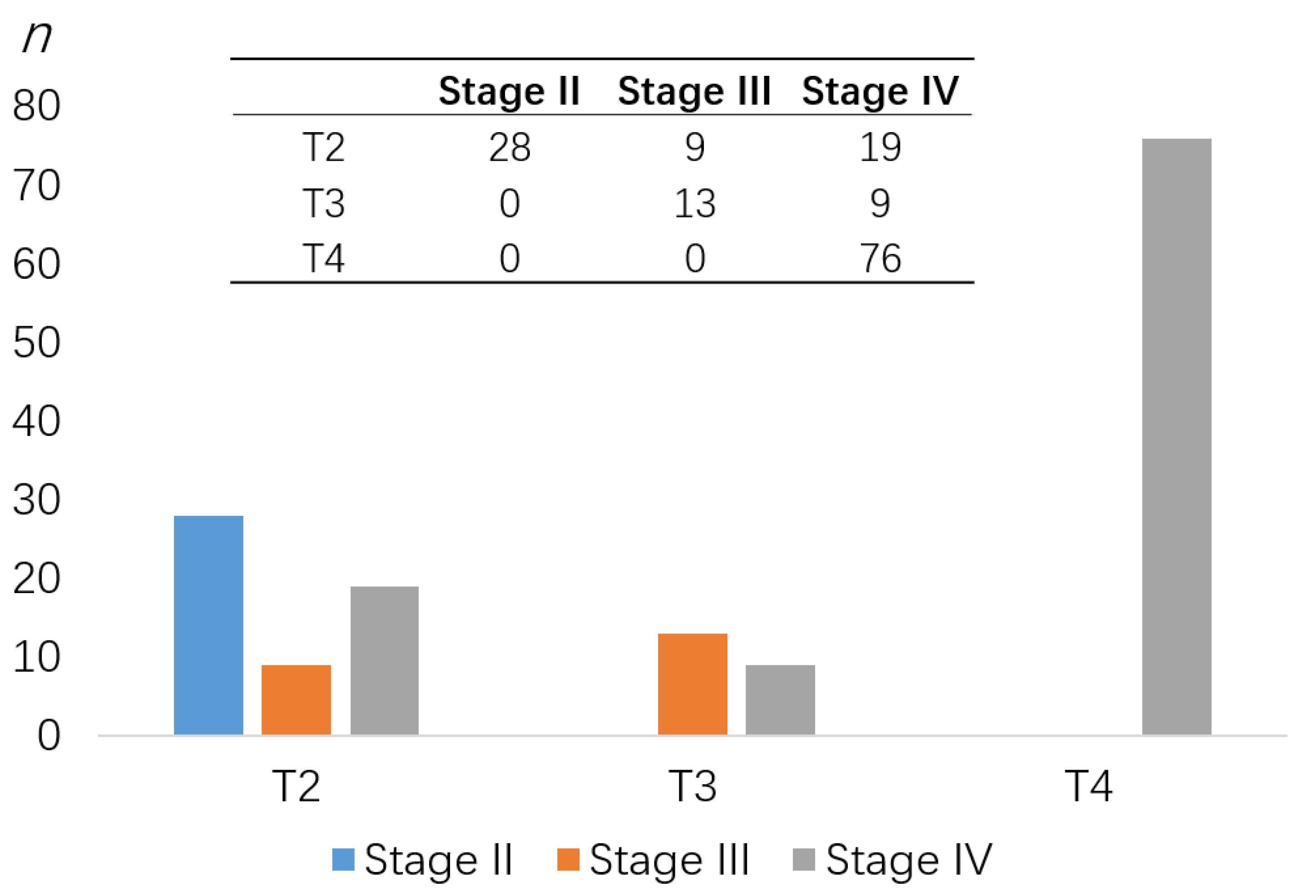

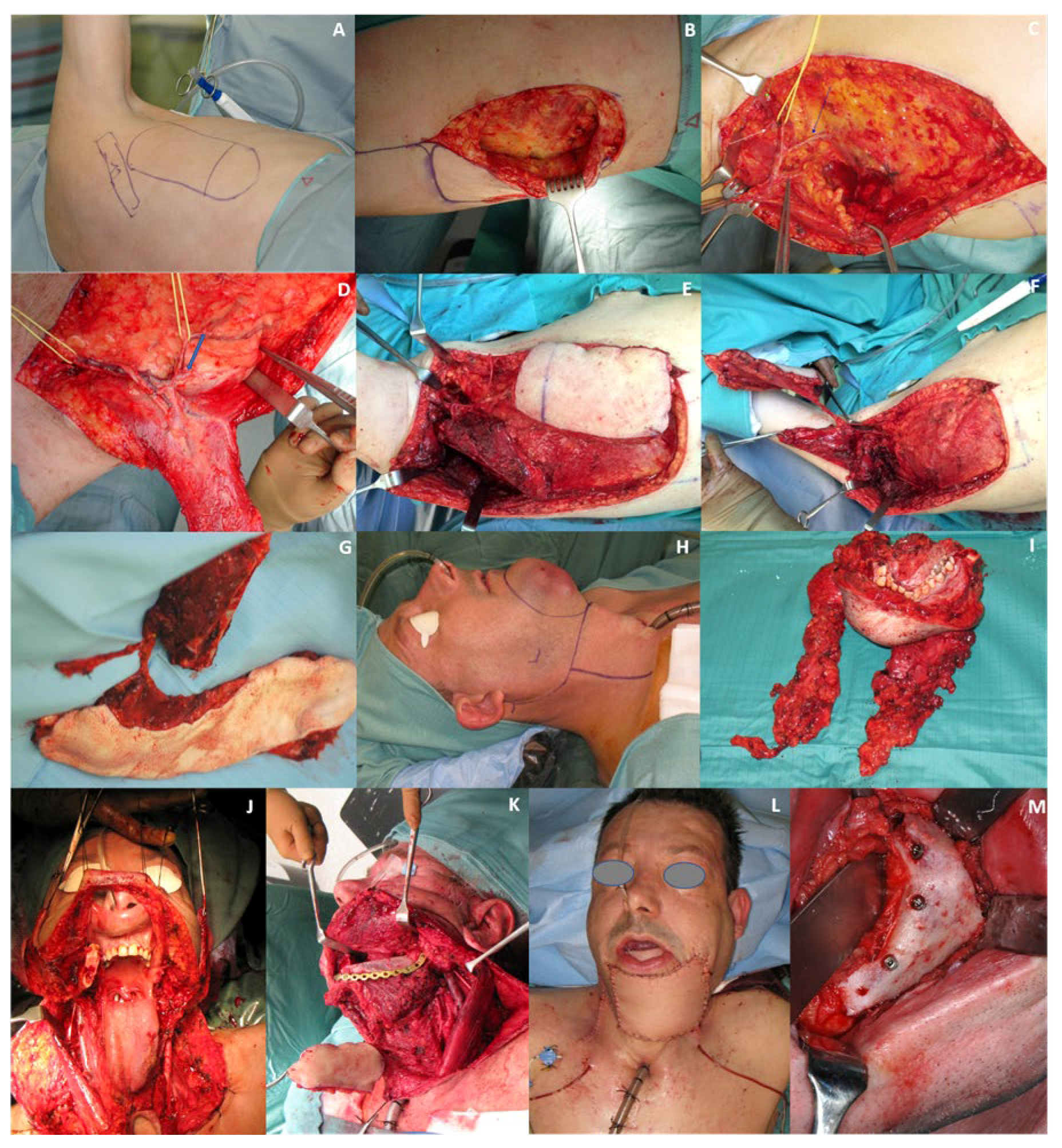
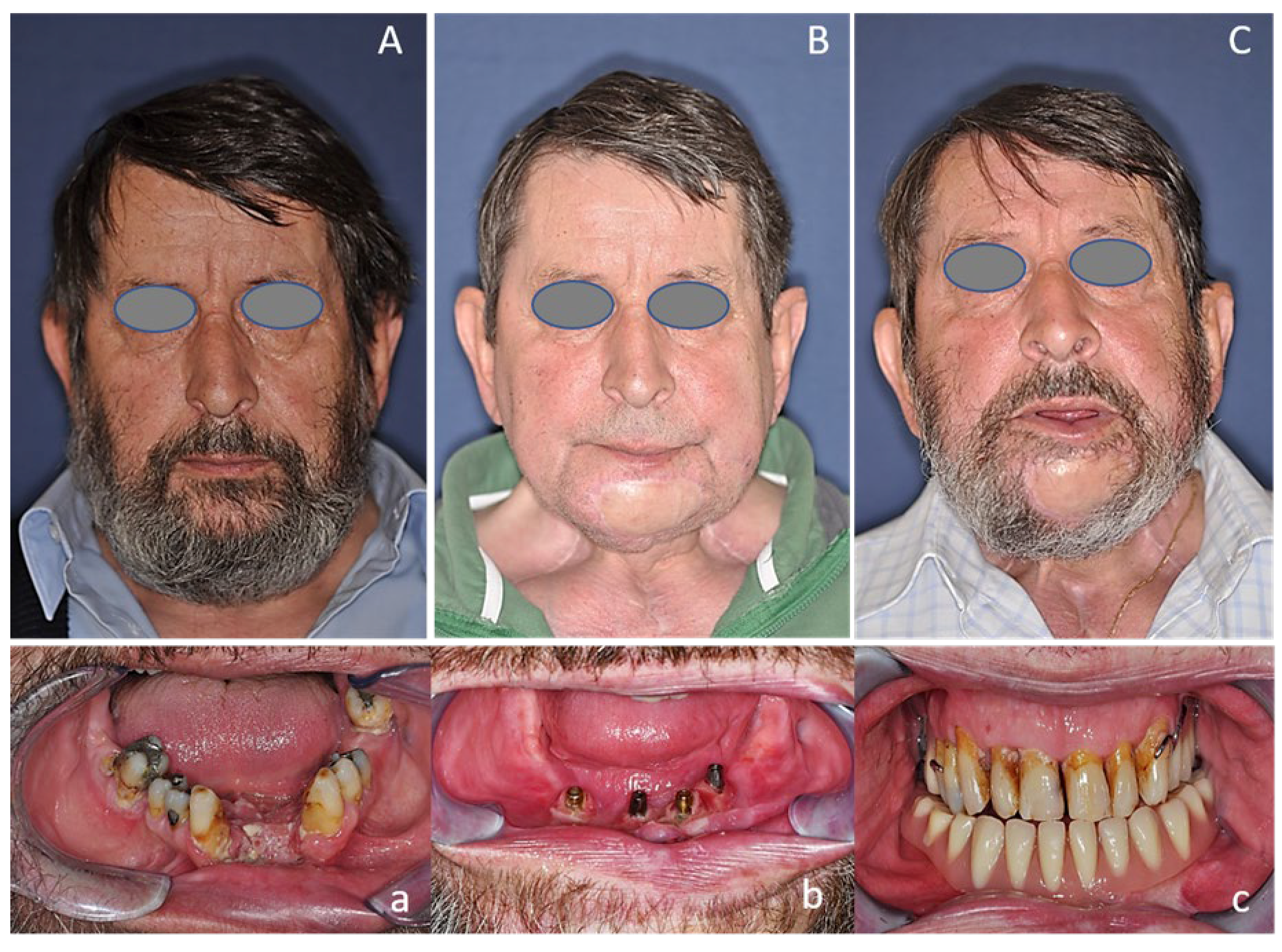
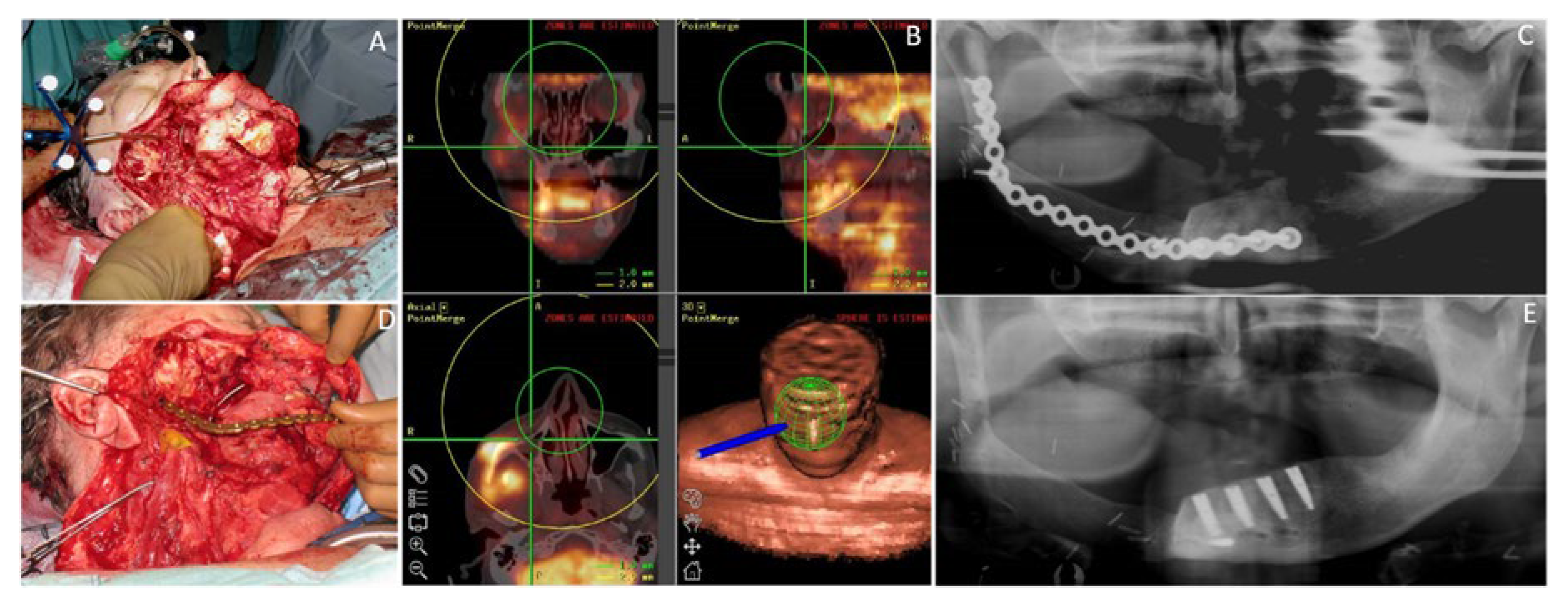
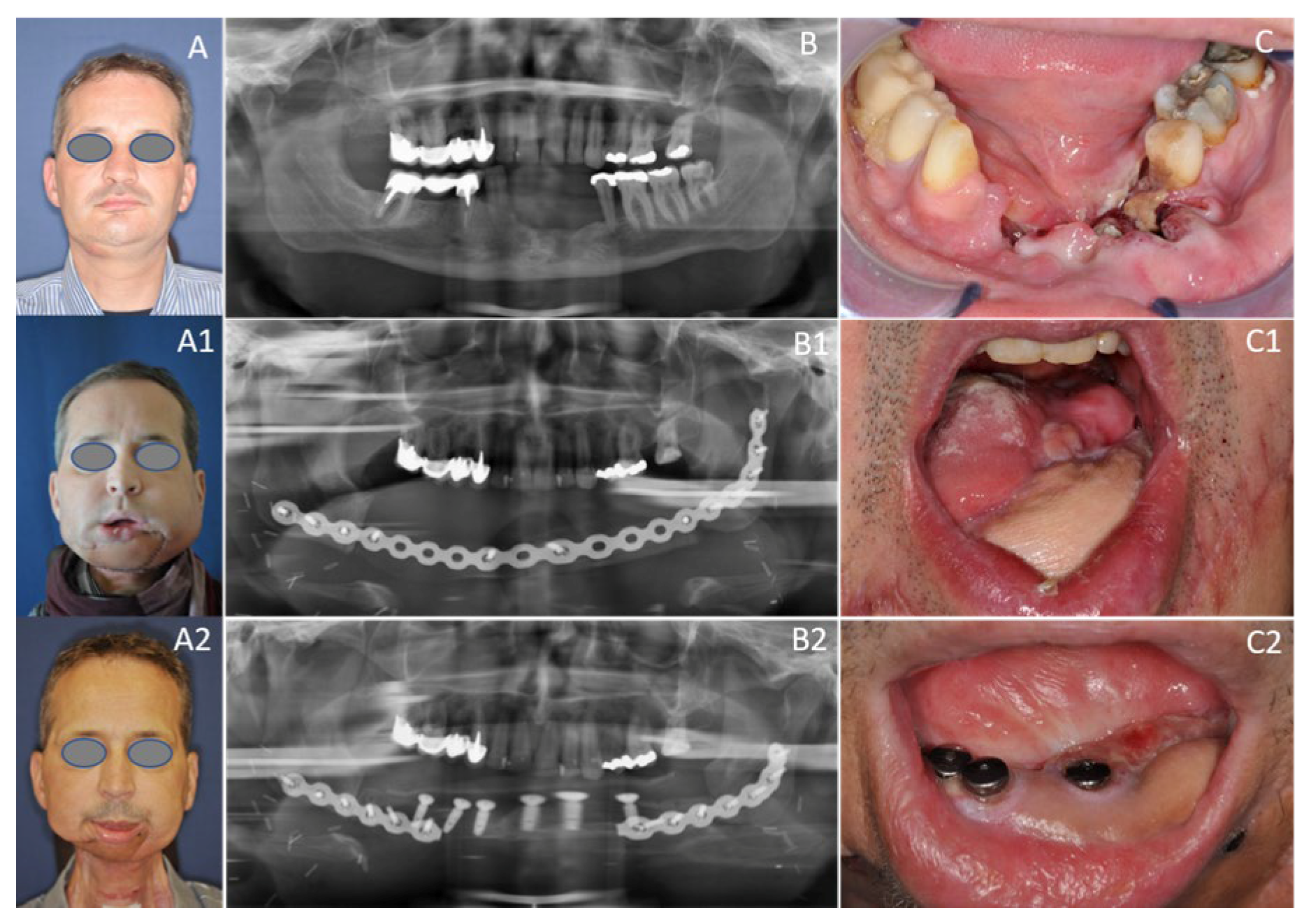
| EORTC QLQ-C30 | Median (Q1/Q3) | Mean ± SD |
|---|---|---|
| Multi-item functional scales | ||
| Physical functioning | 66.7 (40/75) | 63.2 ± 22.7 |
| Role functioning | 50 (16.7/66.7) | 50.0 ± 32.7 |
| Cognitive functioning | 83.3 (66.7/100) | 77.8 ± 25.7 |
| Emotional functioning | 75 (41.7/83.3) | 66.7 ± 26.4 |
| Social functioning | 58.3 (16.7/70.8) | 47.6 ± 33.2 |
| Multi-item symptom scales | ||
| Fatigue | 44.4 (22.2/66.7) | 47 ± 25.5 |
| Bodily pain | 33.3 (16.7/33.3) | 34.4 ± 29.2 |
| Nausea/Vomiting | 0 (0/16.7) | 6.3 ± 10.3 |
| Single item symptom scales | ||
| Dyspnea | 33.3 (0/33.3) | 27.1 ± 30.4 |
| Appetite loss | 16.7 (0/33.3) | 23.8 ± 30.5 |
| Sleep disturbance | 33.3 (0/66.7) | 41.7 ± 39.4 |
| Constipation | 16.7 (0/58.3) | 29.2 ± 36.3 |
| Diarrhea | 0 (0/25) | 8.3 ± 14.9 |
| Financial difficulty | 33.3 (0/66.7) | 35.6 ± 34.4 |
| Global health status and quality of life | 50 (41.7/75) | 59.4 ± 20.9 |
| EORTC QLQ-H&N43 | Median (Q1/Q3) | Mean ± SD |
|---|---|---|
| Multi-item scales | ||
| Anxiety | 33.3 (33.3/75) | 49 ± 30.1 |
| Skin problems | 11.1 (0/22.2) | 13.2 ± 11.6 |
| Body image | 27.8 (0/75) | 36.8 ± 35.3 |
| Dry mouth/sticky saliva | 50 (50/66.7) | 52.2 ± 26.6 |
| Social eating | 62.5 (14.6/83.3) | 52 ± 36 |
| Swallowing | 50 (33.3/75) | 53.7 ± 28.5 |
| Pain in the mouth | 16.7 (8.3/33.3) | 25.6 ± 24.1 |
| Shoulder problems | 66.7 (16.7/83.3) | 57.8 ± 35.6 |
| Sexuality | 50 (0/66.7) | 42.4 ± 40.4 |
| Sense problems | 0 (0/33.3) | 13.5 ± 20.4 |
| Speech problems | 51.7 (8.3/71.7) | 46.5 ± 33.4 |
| Teeth | 72.2 (33.3/100) | 63.1 ± 32.1 |
| Single-item scales | ||
| Weight loss | 33.3 (0/33.3) | 33.3 ± 32.2 |
| Swelling in the neck | 16.7 (0/58.3) | 29.2 ± 36.3 |
| Coughing | 16.7 (0/33.3) | 16.7 ± 17.2 |
| Opening mouth | 66.7 (33.3/83.3) | 62.2 ± 30.5 |
| Neurologic problems | 16.7 (0/33.3) | 25 ± 33.3 |
| Social contact | 0 (0/66.7) | 33.3 ± 42.2 |
| Wound healing | 0 (0/66.7) | 25 ± 31 |
Publisher’s Note: MDPI stays neutral with regard to jurisdictional claims in published maps and institutional affiliations. |
© 2020 by the authors. Licensee MDPI, Basel, Switzerland. This article is an open access article distributed under the terms and conditions of the Creative Commons Attribution (CC BY) license (http://creativecommons.org/licenses/by/4.0/).
Share and Cite
Zrnc, T.A.; Tomic, J.; Tomazic, P.V.; Hassanzadeh, H.; Feichtinger, M.; Zemann, W.; Metzler, P.; Pau, M. Complex Mandibular Reconstruction for Head and Neck Squamous Cell Carcinoma—The Ongoing Challenge in Reconstruction and Rehabilitation. Cancers 2020, 12, 3198. https://doi.org/10.3390/cancers12113198
Zrnc TA, Tomic J, Tomazic PV, Hassanzadeh H, Feichtinger M, Zemann W, Metzler P, Pau M. Complex Mandibular Reconstruction for Head and Neck Squamous Cell Carcinoma—The Ongoing Challenge in Reconstruction and Rehabilitation. Cancers. 2020; 12(11):3198. https://doi.org/10.3390/cancers12113198
Chicago/Turabian StyleZrnc, Tomislav A., Josip Tomic, Peter V. Tomazic, Hamid Hassanzadeh, Matthias Feichtinger, Wolfgang Zemann, Philipp Metzler, and Mauro Pau. 2020. "Complex Mandibular Reconstruction for Head and Neck Squamous Cell Carcinoma—The Ongoing Challenge in Reconstruction and Rehabilitation" Cancers 12, no. 11: 3198. https://doi.org/10.3390/cancers12113198
APA StyleZrnc, T. A., Tomic, J., Tomazic, P. V., Hassanzadeh, H., Feichtinger, M., Zemann, W., Metzler, P., & Pau, M. (2020). Complex Mandibular Reconstruction for Head and Neck Squamous Cell Carcinoma—The Ongoing Challenge in Reconstruction and Rehabilitation. Cancers, 12(11), 3198. https://doi.org/10.3390/cancers12113198





